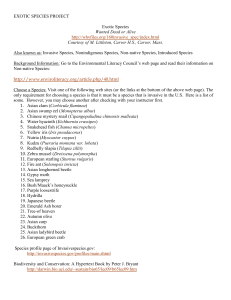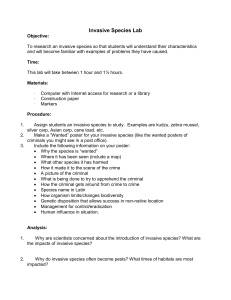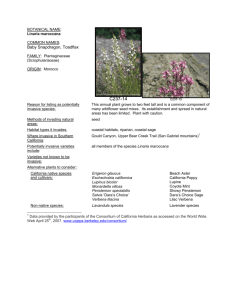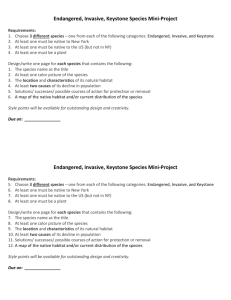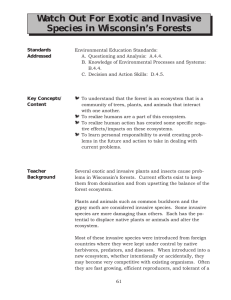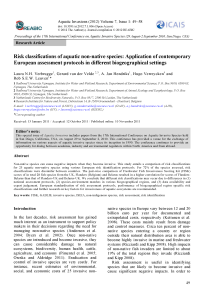Unwanted Invasive Species
advertisement
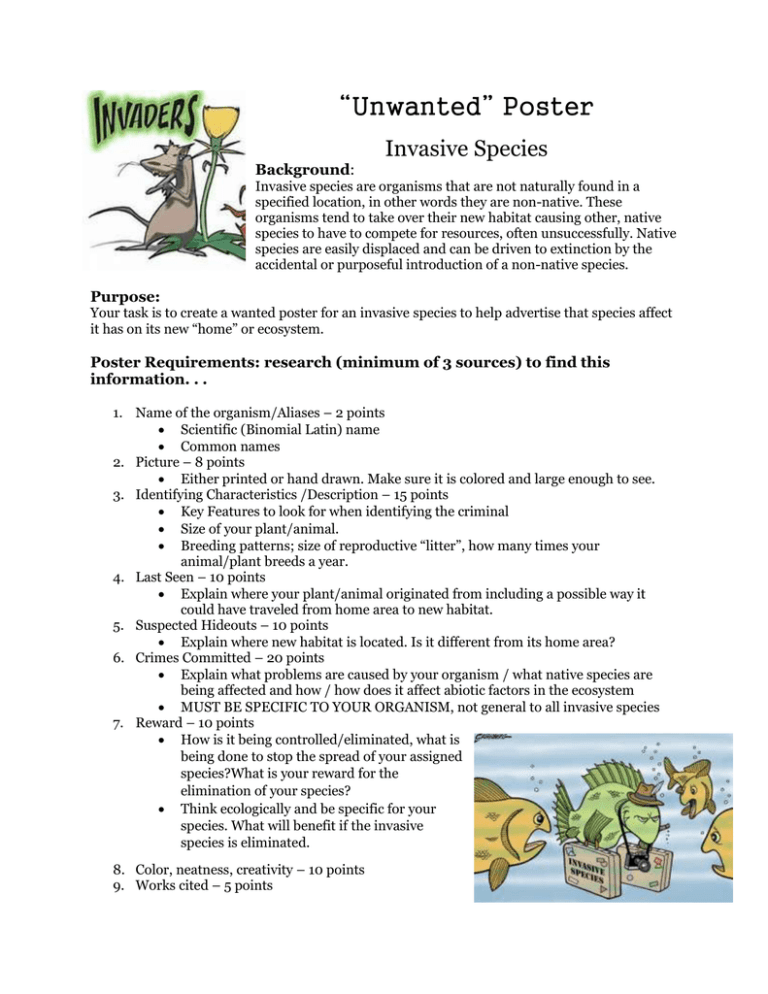
“Unwanted” Poster Invasive Species Background: Invasive species are organisms that are not naturally found in a specified location, in other words they are non-native. These organisms tend to take over their new habitat causing other, native species to have to compete for resources, often unsuccessfully. Native species are easily displaced and can be driven to extinction by the accidental or purposeful introduction of a non-native species. Purpose: Your task is to create a wanted poster for an invasive species to help advertise that species affect it has on its new “home” or ecosystem. Poster Requirements: research (minimum of 3 sources) to find this information. . . 1. Name of the organism/Aliases – 2 points Scientific (Binomial Latin) name Common names 2. Picture – 8 points Either printed or hand drawn. Make sure it is colored and large enough to see. 3. Identifying Characteristics /Description – 15 points Key Features to look for when identifying the criminal Size of your plant/animal. Breeding patterns; size of reproductive “litter”, how many times your animal/plant breeds a year. 4. Last Seen – 10 points Explain where your plant/animal originated from including a possible way it could have traveled from home area to new habitat. 5. Suspected Hideouts – 10 points Explain where new habitat is located. Is it different from its home area? 6. Crimes Committed – 20 points Explain what problems are caused by your organism / what native species are being affected and how / how does it affect abiotic factors in the ecosystem MUST BE SPECIFIC TO YOUR ORGANISM, not general to all invasive species 7. Reward – 10 points How is it being controlled/eliminated, what is being done to stop the spread of your assigned species?What is your reward for the elimination of your species? Think ecologically and be specific for your species. What will benefit if the invasive species is eliminated. 8. Color, neatness, creativity – 10 points 9. Works cited – 5 points Invasive Species Invertebrates: 1. 2. 3. 4. 5. 6. 7. 8. 9. 10. 11. 12. 13. 14. 15. 16. 17. Africanized Honey Bee Red Fire Ant Khapra Beetle Giant African Snail Asian Clams Zebra Mussel Black Tiger Shrimp Raspberry Crazy Ants Apple Snails Asian Tiger Mosquito European Green Crabs Asian Long-horned beetle Emerald Ash Borer Veined Rapa Whelk Gypsy moth Chinese Mitten Crab Formosan Termite Vertebrates: 1. 2. 3. 4. 5. 6. 7. 8. 9. Cane Toad European Starling Brown Tree Snake Nutria Feral Hogs Asian Carps Asian Swamp Eel Flathead Catfish European Wild Boar 10. 11. 12. 13. 14. 15. 16. 17. 18. Sea Lamprey Round goby Common Pigeon Lion fish Eurasian Ruffe Norway Rat Muscovy Duck Common Boa Burmese Python Plants: 1. 2. 3. 4. 5. 6. 7. 8. 9. 10. 11. 12. 13. 14. 15. 16. 17. Chinese Tallow Tree Giant Salvinia Deep Rooted Sedge Salt Cedar Crested Floating Heart Hydrilla Russian Olive Kudzu Purple Loosestrife Water Hyacinth Water Lettuce Mexican Petunia Giant Duckweed Japanese Climbing Fern Chinaberry Giant Reed Chinese and European Privet
